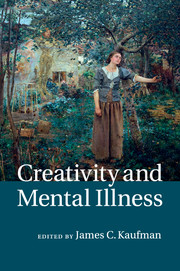Book contents
- Frontmatter
- Dedication
- Contents
- List of figures
- List of tables
- List of contributors
- Preface
- Acknowledgments
- Part I Creativity and mental illness: the state of the field
- Part II Cognitive and neuroscientific perspectives on creativity and mental illness
- 5 Neurocognitive mechanisms underlying creative thinking: indications from studies of mental illness
- 6 The evolutionary genetics of the creativity–psychosis connection
- 7 Non-linearity in creativity and mental illness: the mixed blessings of chaos, catastrophe, and noise in brain and behavior
- 8 Artists’ vulnerability to psychopathology: an integrative cognitive perspective
- Part III Creativity and the spectrum of mental illness
- Part IV Creativity and mental illness: possible commonalities
- Part V Creativity and mental health
- Part VI Creativity and mental illness: what now?
- Index
- References
7 - Non-linearity in creativity and mental illness: the mixed blessings of chaos, catastrophe, and noise in brain and behavior
from Part II - Cognitive and neuroscientific perspectives on creativity and mental illness
Published online by Cambridge University Press: 05 August 2014
- Frontmatter
- Dedication
- Contents
- List of figures
- List of tables
- List of contributors
- Preface
- Acknowledgments
- Part I Creativity and mental illness: the state of the field
- Part II Cognitive and neuroscientific perspectives on creativity and mental illness
- 5 Neurocognitive mechanisms underlying creative thinking: indications from studies of mental illness
- 6 The evolutionary genetics of the creativity–psychosis connection
- 7 Non-linearity in creativity and mental illness: the mixed blessings of chaos, catastrophe, and noise in brain and behavior
- 8 Artists’ vulnerability to psychopathology: an integrative cognitive perspective
- Part III Creativity and the spectrum of mental illness
- Part IV Creativity and mental illness: possible commonalities
- Part V Creativity and mental health
- Part VI Creativity and mental illness: what now?
- Index
- References
Summary
The emergent capacity for creative abstraction allows humans to alter our concepts and behaviors quickly and have new ones that might not be an easy extension of current ideas. We can model some of the consequences of our actions in the dramatic workplace of our imagination, and generate new ideas. However, principles of overproduction, error, and culling still apply, in the realm of creative abstraction: Many of our ideas are fatal, larger proportions still are significantly out of touch with reality or insane, and those that are neither fatal nor insane are generally impractical. Indeed, the vast majority of new inventions do not reach the marketplace and most new businesses fail within 10 years (Shane, 2008). Perhaps it is for this fundamental reason that creativity and insanity appear linked by eternal intuition: In the hunt for a solution, more ideas are better, but most ideas are still bad. The conservative strategy may therefore be to avoid new ideas altogether, and that is a common approach. Many people appear neither intelligent nor open enough to be genuinely creative, and only a small proportion of those few who manifest creativity are also sufficiently disciplined and emotionally stable to see their ideas realized. The typical best strategy may therefore be to do whatever everyone else does. This is what animals generally do, and it generally works (Kaufman et al., 2011). Nonetheless, stasis also presents its dangers. Because situations change, creativity is necessary and valued to accommodate new circumstances, despite its dangers.
So we may ask such questions as: Where do new ideas come from?; Who generates them?; and How are they generated? Some answers may be forthcoming from the fields of artificial intelligence that attempt to model human creativity. Human beings are constrained and low-capacity processors. Our perceptions are necessarily low-resolution representations of an almost infinitely high-resolution reality. Likewise, our concepts are mere shadows of our perceptions. The informational array that constantly presents itself to us can be simplified, for pragmatic purposes, just as a low-resolution photograph can stand as a substitute for a high-resolution photograph (which can, in turn, stand as a substitute for the thing it represents). Thus, the same “thing-in-itself” can be perceived in many different ways, none of which are necessarily more or less accurate than any other (except insofar as they serve, or fail to serve, some motivated purpose).
- Type
- Chapter
- Information
- Creativity and Mental Illness , pp. 133 - 144Publisher: Cambridge University PressPrint publication year: 2014



